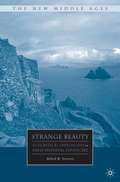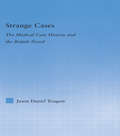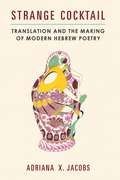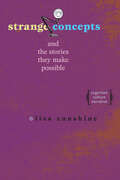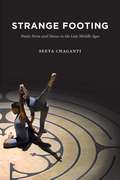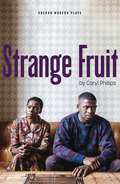- Table View
- List View
Strands of Utopia: Spaces of Poetic Work in Twentieth Century France
by Michael G Kelly"The poetic is an abiding yet elusive qualification within the discursive system of twentieth-century French literature. No longer amenable to formal assignment, its recurrences delimit a shifting, multi-layered practice of artistic and intellectual (self-) invention. This study attempts to outline certain durable properties of that practice by confronting it with the complex theoretical and spatial metaphor of utopia. Drawing, in particular, upon the oeuvres of Victor Segalen (1878-1919), Rene Daumal (1908-44) and Yves Bonnefoy (b. 1923), it traces poetic work - work done in support of poetic difference - along the social, physical and textual axes of what is argued to be a sustained and radically inclusive utopian practice within the literary field. The complex utopian quality of poetic work is linked to the cultural persistence of the poetic as a simple attribute within literary practice. In uncovering this link, the study encourages revised understandings of both the poetic and the utopian in the modern French literary context."
Strands of Utopia: Spaces of Poetic Work in Twentieth Century France
by Michael G Kelly"The poetic is an abiding yet elusive qualification within the discursive system of twentieth-century French literature. No longer amenable to formal assignment, its recurrences delimit a shifting, multi-layered practice of artistic and intellectual (self-) invention. This study attempts to outline certain durable properties of that practice by confronting it with the complex theoretical and spatial metaphor of utopia. Drawing, in particular, upon the oeuvres of Victor Segalen (1878-1919), Rene Daumal (1908-44) and Yves Bonnefoy (b. 1923), it traces poetic work - work done in support of poetic difference - along the social, physical and textual axes of what is argued to be a sustained and radically inclusive utopian practice within the literary field. The complex utopian quality of poetic work is linked to the cultural persistence of the poetic as a simple attribute within literary practice. In uncovering this link, the study encourages revised understandings of both the poetic and the utopian in the modern French literary context."
Strange and Secret Peoples: Fairies and Victorian Consciousness
by Carole G. SilverTeeming with creatures, both real and imagined, this encyclopedic study in cultural history illuminates the hidden web of connections between the Victorian fascination with fairies and their lore and the dominant preoccupations of Victorian culture at large. Carole Silver here draws on sources ranging from the anthropological, folkloric, and occult to the legal, historical, and medical. She is the first to anatomize a world peopled by strange beings who have infiltrated both the literary and visual masterpieces and the minor works of the writers and painters of that era. Examining the period of 1798 to 1923, Strange and Secret Peoples focuses not only on such popular literary figures as Charles Dickens and William Butler Yeats, but on writers as diverse as Thomas Carlyle, Arthur Conan Doyle, and Charlotte Mew; on artists as varied as mad Richard Dadd, Aubrey Beardsley, and Sir Joseph Noel Paton; and on artifacts ranging from fossil skulls to photographs and vases. Silver demonstrates how beautiful and monstrous creatures--fairies and swan maidens, goblins and dwarfs, cretins and changelings, elementals and pygmies--simultaneously peopled the Victorian imagination and inhabited nineteenth-century science and belief. Her book reveals the astonishing complexity and fertility of the Victorian consciousness: its modernity and antiquity, its desire to naturalize the supernatural, its pervasive eroticism fused with sexual anxiety, and its drive for racial and imperial dominion.
Strange Antics: A History Of Seduction
by Clement KnoxWhen is seduction about more than just sex? In this brilliantly original history, Clement Knox explores these questions as well as the philosophy, legality, politics, art and literature of a force that underwrites our world.
Strange Beauty: Ecocritical Approaches to Early Medieval Landscape (The New Middle Ages)
by A. SiewersStrange Beauty provides a new perspective on early Celtic stories of the Otherworld and their relevance to today's ecological concerns, arguing for a contemporary re-reading of the Otherworld trope in relation to physical experience.
Strange Bridges: Band 6 orange (PDF) (Collins Big Cat Phonics For Letters And Sounds Ser.)
by Isabel ThomasCollins Big Cat Phonics for Letters and Sounds features exciting fiction and non-fiction decodable readers to enthuse and inspire children. They are fully aligned to Letters and Sounds Phases 1-6 and contain notes in the back. The Handbooks provide support in demonstration and modelling, monitoring comprehension and expanding vocabulary. Find out all about the different unusual bridges around the world, from see-through bridges to ones that look like dragons, in this photographic non-fiction book by Isabel Thomas. Orange/Band 6 books offer varied text and characters, with action sustained over several pages. The focus sounds in this book are: /ai/ eigh /ee/ e-e, ey, e, y /oo/ u /igh/ y /c/ ch /j/ g, ge, dge /l/ le /f/ ph /w/ wh /v/ ve /s/ se /z/ se Pages 22 and 23 allow children to re-visit the content of the book, supporting comprehension skills, vocabulary development and recall. Reading notes within the book provide practical support for reading Big Cat Phonics for Letters and Sounds with children, including a list of all the sounds and words that the book will cover.
The Strange Career of Racial Liberalism (Post*45)
by Joseph DardaHow Americans learned to wait on time for racial change What if, Joseph Darda asks, our desire to solve racism—with science, civil rights, antiracist literature, integration, and color blindness—has entrenched it further? In The Strange Career of Racial Liberalism, he traces the rise of liberal antiracism, showing how reformers' faith in time, in the moral arc of the universe, has undercut future movements with the insistence that racism constitutes a time-limited crisis to be solved with time-limited remedies. Most historians attribute the shortcomings of the civil rights era to a conservative backlash or to the fracturing of the liberal establishment in the late 1960s, but the civil rights movement also faced resistance from a liberal "frontlash," from antiredistributive allies who, before it ever took off, constrained what the movement could demand and how it could demand it. Telling the stories of Ruth Benedict, Kenneth Clark, W. E. B. Du Bois, John Howard Griffin, Pauli Murray, Lillian Smith, Richard Wright, and others, Darda reveals how Americans learned to wait on time for racial change and the enduring harm of that trust in the clock.
Strange Case of Dr Jekyll and Mr Hyde: EMC Study Edition (PDF)
by Robert Louis StevensonSuitable for use across all specifications, this study edition includes the full text, divided into manageable sections with short 'getting the reading done' activities suitable for class work, or to support students reading the text individually. More extensive before and after reading resources provide material for studying the text in class. These cover key ideas in the text, make connections between the text and its context and include a helpful section on exam preparation and revision.
Strange Cases: The Medical Case History and the British Novel (Literary Criticism and Cultural Theory)
by Jason TougawStrange Cases is the story of the mutual influence of the case history and the British novel during the eighteenth and nineteenth centuries. Fictions from Defoe's Roxana to James's The Turn of the Screw and case histories from George Cheyne's to Sigmund Freud's have found narrative impetus in pathology. The writer of a case history faces a rhetorical bind unique to the human sciences: the need to display the acumen of a scientist and the sympathy warranted to the suffering patient. Repeatedly, case historians justify their publicizing of extreme, often morbid or perverse, states of mind and body by appealing to readers to take pity on patients and to recognize the narrative as a vital social document. Diagnosis and sympathy, explicit rhetorical modes in case histories, operate implicitly in novels, shaping reader-identification. While these two narrative forms set out to fulfill an Enlightenment drive to classify and explain, they also raise social and epistemological questions that challenge some of the Enlightenment's most cherished ideals, including faith in reason, the perfectibility of humankind, and the stability of truth.
Strange Cases: The Medical Case History and the British Novel (Literary Criticism and Cultural Theory)
by Jason TougawStrange Cases is the story of the mutual influence of the case history and the British novel during the eighteenth and nineteenth centuries. Fictions from Defoe's Roxana to James's The Turn of the Screw and case histories from George Cheyne's to Sigmund Freud's have found narrative impetus in pathology. The writer of a case history faces a rhetorical bind unique to the human sciences: the need to display the acumen of a scientist and the sympathy warranted to the suffering patient. Repeatedly, case historians justify their publicizing of extreme, often morbid or perverse, states of mind and body by appealing to readers to take pity on patients and to recognize the narrative as a vital social document. Diagnosis and sympathy, explicit rhetorical modes in case histories, operate implicitly in novels, shaping reader-identification. While these two narrative forms set out to fulfill an Enlightenment drive to classify and explain, they also raise social and epistemological questions that challenge some of the Enlightenment's most cherished ideals, including faith in reason, the perfectibility of humankind, and the stability of truth.
Strange Cocktail: Translation and the Making of Modern Hebrew Poetry (Michigan Studies In Comparative Jewish Cultures)
by Adriana X. JacobsFor centuries, poets have turned to translation for creative inspiration. Through and in translation, poets have introduced new poetic styles, languages, and forms into their own writing, sometimes changing the course of literary history in the process. Strange Cocktail is the first comprehensive study of this phenomenon in modern Hebrew literature of the late nineteenth century to the present day. Its chapters on Esther Raab, Leah Goldberg, Avot Yeshurun, and Harold Schimmel offer close readings that examine the distinct poetics of translation that emerge from reciprocal practices of writing and translating. Working in a minor literary vernacular, the translation strategies that these poets employed allowed them to create and participate in transnational and multilingual poetic networks. Strange Cocktail thereby advances a comparative and multilingual reframing of modern Hebrew literature that considers how canons change and are undone when translation occupies a central position—how lines of influence and affiliation are redrawn and literary historiographies are revised when the work of translation occupies the same status as an original text, when translating and writing go hand in hand.
Strange Concepts and the Stories They Make Possible: Cognition, Culture, Narrative
by Lisa ZunshineIn this fresh and often playful interdisciplinary study, Lisa Zunshine presents a fluid discussion of how key concepts from cognitive science complicate our cultural interpretations of "strange" literary phenomena.From Short Circuit to I, Robot, from The Parent Trap to Big Business, fantastic tales of rebellious robots, animated artifacts, and twins mistaken for each other are a permanent fixture in popular culture and have been since antiquity. Why do these strange concepts captivate the human imagination so thoroughly? Zunshine explores how cognitive science, specifically its ideas of essentialism and functionalism, combined with historical and cultural analysis, can help us understand why we find such literary phenomena so fascinating.Drawing from research by such cognitive evolutionary anthropologists and psychologists as Scott Atran, Paul Bloom, Pascal Boyer, and Susan A. Gelman, Zunshine examines the cognitive origins of the distinction between essence and function and how unexpected tensions between these two concepts are brought into play in fictional narratives. Discussing motifs of confused identity and of twins in drama, science fiction’s use of robots, cyborgs, and androids, and nonsense poetry and surrealist art, she reveals the range and power of key concepts from science in literary interpretation and provides insight into how cognitive-evolutionary research on essentialism can be used to study fiction as well as everyday strange concepts.
Strange Footing: Poetic Form and Dance in the Late Middle Ages
by Seeta ChagantiFor premodern audiences, poetic form did not exist solely as meter, stanzas, or rhyme scheme. Rather, the form of a poem emerged as an experience, one generated when an audience immersed in a culture of dance encountered a poetic text. Exploring the complex relationship between medieval dance and medieval poetry, Strange Footing argues that the intersection of texts and dance produced an experience of poetic form based in disorientation, asymmetry, and even misstep. Medieval dance guided audiences to approach poetry not in terms of the body’s regular marking of time and space, but rather in the irregular and surprising forces of virtual motion around, ahead of, and behind the dancing body. Reading medieval poems through artworks, paintings, and sculptures depicting dance, Seeta Chaganti illuminates texts that have long eluded our full understanding, inviting us to inhabit their strange footings askew of conventional space and time. Strange Footing deploys the motion of dance to change how we read medieval poetry, generating a new theory of poetic form for medieval studies and beyond.
Strange Footing: Poetic Form and Dance in the Late Middle Ages
by Seeta ChagantiFor premodern audiences, poetic form did not exist solely as meter, stanzas, or rhyme scheme. Rather, the form of a poem emerged as an experience, one generated when an audience immersed in a culture of dance encountered a poetic text. Exploring the complex relationship between medieval dance and medieval poetry, Strange Footing argues that the intersection of texts and dance produced an experience of poetic form based in disorientation, asymmetry, and even misstep. Medieval dance guided audiences to approach poetry not in terms of the body’s regular marking of time and space, but rather in the irregular and surprising forces of virtual motion around, ahead of, and behind the dancing body. Reading medieval poems through artworks, paintings, and sculptures depicting dance, Seeta Chaganti illuminates texts that have long eluded our full understanding, inviting us to inhabit their strange footings askew of conventional space and time. Strange Footing deploys the motion of dance to change how we read medieval poetry, generating a new theory of poetic form for medieval studies and beyond.
Strange Footing: Poetic Form and Dance in the Late Middle Ages
by Seeta ChagantiFor premodern audiences, poetic form did not exist solely as meter, stanzas, or rhyme scheme. Rather, the form of a poem emerged as an experience, one generated when an audience immersed in a culture of dance encountered a poetic text. Exploring the complex relationship between medieval dance and medieval poetry, Strange Footing argues that the intersection of texts and dance produced an experience of poetic form based in disorientation, asymmetry, and even misstep. Medieval dance guided audiences to approach poetry not in terms of the body’s regular marking of time and space, but rather in the irregular and surprising forces of virtual motion around, ahead of, and behind the dancing body. Reading medieval poems through artworks, paintings, and sculptures depicting dance, Seeta Chaganti illuminates texts that have long eluded our full understanding, inviting us to inhabit their strange footings askew of conventional space and time. Strange Footing deploys the motion of dance to change how we read medieval poetry, generating a new theory of poetic form for medieval studies and beyond.
Strange Footing: Poetic Form and Dance in the Late Middle Ages
by Seeta ChagantiFor premodern audiences, poetic form did not exist solely as meter, stanzas, or rhyme scheme. Rather, the form of a poem emerged as an experience, one generated when an audience immersed in a culture of dance encountered a poetic text. Exploring the complex relationship between medieval dance and medieval poetry, Strange Footing argues that the intersection of texts and dance produced an experience of poetic form based in disorientation, asymmetry, and even misstep. Medieval dance guided audiences to approach poetry not in terms of the body’s regular marking of time and space, but rather in the irregular and surprising forces of virtual motion around, ahead of, and behind the dancing body. Reading medieval poems through artworks, paintings, and sculptures depicting dance, Seeta Chaganti illuminates texts that have long eluded our full understanding, inviting us to inhabit their strange footings askew of conventional space and time. Strange Footing deploys the motion of dance to change how we read medieval poetry, generating a new theory of poetic form for medieval studies and beyond.
Strange Footing: Poetic Form and Dance in the Late Middle Ages
by Seeta ChagantiFor premodern audiences, poetic form did not exist solely as meter, stanzas, or rhyme scheme. Rather, the form of a poem emerged as an experience, one generated when an audience immersed in a culture of dance encountered a poetic text. Exploring the complex relationship between medieval dance and medieval poetry, Strange Footing argues that the intersection of texts and dance produced an experience of poetic form based in disorientation, asymmetry, and even misstep. Medieval dance guided audiences to approach poetry not in terms of the body’s regular marking of time and space, but rather in the irregular and surprising forces of virtual motion around, ahead of, and behind the dancing body. Reading medieval poems through artworks, paintings, and sculptures depicting dance, Seeta Chaganti illuminates texts that have long eluded our full understanding, inviting us to inhabit their strange footings askew of conventional space and time. Strange Footing deploys the motion of dance to change how we read medieval poetry, generating a new theory of poetic form for medieval studies and beyond.
Strange Footing: Poetic Form and Dance in the Late Middle Ages
by Seeta ChagantiFor premodern audiences, poetic form did not exist solely as meter, stanzas, or rhyme scheme. Rather, the form of a poem emerged as an experience, one generated when an audience immersed in a culture of dance encountered a poetic text. Exploring the complex relationship between medieval dance and medieval poetry, Strange Footing argues that the intersection of texts and dance produced an experience of poetic form based in disorientation, asymmetry, and even misstep. Medieval dance guided audiences to approach poetry not in terms of the body’s regular marking of time and space, but rather in the irregular and surprising forces of virtual motion around, ahead of, and behind the dancing body. Reading medieval poems through artworks, paintings, and sculptures depicting dance, Seeta Chaganti illuminates texts that have long eluded our full understanding, inviting us to inhabit their strange footings askew of conventional space and time. Strange Footing deploys the motion of dance to change how we read medieval poetry, generating a new theory of poetic form for medieval studies and beyond.
Strange Fruit (Oberon Modern Plays)
by Caryl Phillips"I go half way round the world and back thinking I’d made some sort of discovery and come back to find the same damn lies, the same white lies, the same black lies." Alvin and Errol can’t picture much of a future for themselves. They’re young, Black and living in England in the 1980s, with an entire country and political system set against them. Instead they focus firmly on their past – the sunny Caribbean and heroic father they left behind when their mother brought them to England twenty years ago. But when Alvin returns home from his grandfather’s funeral a new version of their past emerges, and the two brothers are caught in a desperate struggle to unearth the truth about their existence. Powerful and compelling, Strange Fruit by Caryl Phillips (winner of the Commonwealth Writers’ Prize) is the story of a family caught between two cultures, and the uncrossable no man’s land that can come between parents and their children.
Strange Gods: Love and Idolatry in the Victorian Novel (Among the Victorians and Modernists)
by Timothy L. CarensDespite frequent declarations of the sanctity of love and marriage, British Protestant culture nurtured the fear that human affection might easily slip into idolatry. Throughout the nineteenth-century, theological essays, sermons, hymns, and didactic fiction and poetry urged the faithful to maintain a constant watch over their hearts, lest they become engrossed by human love, guilty of worshipping the creature rather than the Creator. Strange Gods: Love and Idolatry in the Victorian Novel traces the concerns produced in Protestant culture by this broad interpretation of idolatry. In chapters focusing on Charles Kingsley and Charlotte Brontë, Mary Elizabeth Braddon, George Eliot, Oscar Wilde, and Thomas Hardy, this volume shows that even supposedly secular novels obsessively reenact an ideological clash between Protestant faith and human love. Anxiety about adoring humans more than God frequently overshadows and sometimes derails the progress of romance in Victorian novels. By probing this anxiety and its narrative effects, Strange Gods uncovers how a central Protestant belief exerts its influence over stories about love and marriage.
Strange Gods: Love and Idolatry in the Victorian Novel (Among the Victorians and Modernists)
by Timothy L. CarensDespite frequent declarations of the sanctity of love and marriage, British Protestant culture nurtured the fear that human affection might easily slip into idolatry. Throughout the nineteenth-century, theological essays, sermons, hymns, and didactic fiction and poetry urged the faithful to maintain a constant watch over their hearts, lest they become engrossed by human love, guilty of worshipping the creature rather than the Creator. Strange Gods: Love and Idolatry in the Victorian Novel traces the concerns produced in Protestant culture by this broad interpretation of idolatry. In chapters focusing on Charles Kingsley and Charlotte Brontë, Mary Elizabeth Braddon, George Eliot, Oscar Wilde, and Thomas Hardy, this volume shows that even supposedly secular novels obsessively reenact an ideological clash between Protestant faith and human love. Anxiety about adoring humans more than God frequently overshadows and sometimes derails the progress of romance in Victorian novels. By probing this anxiety and its narrative effects, Strange Gods uncovers how a central Protestant belief exerts its influence over stories about love and marriage.
Strange Likeness: Description and the Modernist Novel (Thinking Literature)
by Dora ZhangThe modern novel, so the story goes, thinks poorly of mere description—what Virginia Woolf called “that ugly, that clumsy, that incongruous tool.” As a result, critics have largely neglected description as a feature of novelistic innovation during the twentieth century. Dora Zhang argues that descriptive practices were in fact a crucial site of attention and experimentation for a number of early modernist writers, centrally Woolf, Henry James, and Marcel Proust. Description is the novelistic technique charged with establishing a common world, but in the early twentieth century, there was little agreement about how a common world could be known and represented. Zhang argues that the protagonists in her study responded by shifting description away from visualizing objects to revealing relations—social, formal, and experiential—between disparate phenomena. In addition to shedding new light on some of the best-known works of modernism, Zhang opens up new ways of thinking about description more broadly. She moves us beyond the classic binary of narrate-or-describe and reinvigorates our thinking about the novel. Strange Likeness will enliven conversations around narrative theory, affect theory, philosophy and literature, and reading practices in the academy.
Strange Likeness: Description and the Modernist Novel (Thinking Literature)
by Dora ZhangThe modern novel, so the story goes, thinks poorly of mere description—what Virginia Woolf called “that ugly, that clumsy, that incongruous tool.” As a result, critics have largely neglected description as a feature of novelistic innovation during the twentieth century. Dora Zhang argues that descriptive practices were in fact a crucial site of attention and experimentation for a number of early modernist writers, centrally Woolf, Henry James, and Marcel Proust. Description is the novelistic technique charged with establishing a common world, but in the early twentieth century, there was little agreement about how a common world could be known and represented. Zhang argues that the protagonists in her study responded by shifting description away from visualizing objects to revealing relations—social, formal, and experiential—between disparate phenomena. In addition to shedding new light on some of the best-known works of modernism, Zhang opens up new ways of thinking about description more broadly. She moves us beyond the classic binary of narrate-or-describe and reinvigorates our thinking about the novel. Strange Likeness will enliven conversations around narrative theory, affect theory, philosophy and literature, and reading practices in the academy.
Strange Likeness: Description and the Modernist Novel (Thinking Literature)
by Dora ZhangThe modern novel, so the story goes, thinks poorly of mere description—what Virginia Woolf called “that ugly, that clumsy, that incongruous tool.” As a result, critics have largely neglected description as a feature of novelistic innovation during the twentieth century. Dora Zhang argues that descriptive practices were in fact a crucial site of attention and experimentation for a number of early modernist writers, centrally Woolf, Henry James, and Marcel Proust. Description is the novelistic technique charged with establishing a common world, but in the early twentieth century, there was little agreement about how a common world could be known and represented. Zhang argues that the protagonists in her study responded by shifting description away from visualizing objects to revealing relations—social, formal, and experiential—between disparate phenomena. In addition to shedding new light on some of the best-known works of modernism, Zhang opens up new ways of thinking about description more broadly. She moves us beyond the classic binary of narrate-or-describe and reinvigorates our thinking about the novel. Strange Likeness will enliven conversations around narrative theory, affect theory, philosophy and literature, and reading practices in the academy.
Strange Likeness: Description and the Modernist Novel (Thinking Literature)
by Dora ZhangThe modern novel, so the story goes, thinks poorly of mere description—what Virginia Woolf called “that ugly, that clumsy, that incongruous tool.” As a result, critics have largely neglected description as a feature of novelistic innovation during the twentieth century. Dora Zhang argues that descriptive practices were in fact a crucial site of attention and experimentation for a number of early modernist writers, centrally Woolf, Henry James, and Marcel Proust. Description is the novelistic technique charged with establishing a common world, but in the early twentieth century, there was little agreement about how a common world could be known and represented. Zhang argues that the protagonists in her study responded by shifting description away from visualizing objects to revealing relations—social, formal, and experiential—between disparate phenomena. In addition to shedding new light on some of the best-known works of modernism, Zhang opens up new ways of thinking about description more broadly. She moves us beyond the classic binary of narrate-or-describe and reinvigorates our thinking about the novel. Strange Likeness will enliven conversations around narrative theory, affect theory, philosophy and literature, and reading practices in the academy.



